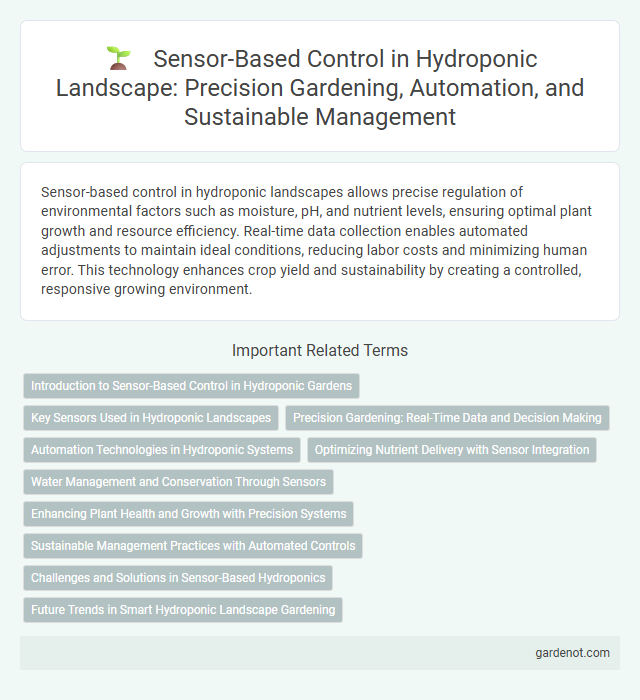Sensor-based control in hydroponic landscapes allows precise regulation of environmental factors such as moisture, pH, and nutrient levels, ensuring optimal plant growth and resource efficiency. Real-time data collection enables automated adjustments to maintain ideal conditions, reducing labor costs and minimizing human error. This technology enhances crop yield and sustainability by creating a controlled, responsive growing environment.
Introduction to Sensor-Based Control in Hydroponic Gardens
Sensor-based control in hydroponic gardens utilizes advanced technologies such as humidity, pH, and nutrient sensors to maintain optimal growing conditions. These systems continuously monitor environmental variables and automatically adjust water delivery, nutrient concentration, and lighting to enhance plant health and maximize yield. Implementing sensor-based control minimizes resource waste and reduces the risk of plant stress caused by fluctuating parameters.
Key Sensors Used in Hydroponic Landscapes
Key sensors used in hydroponic landscapes include pH sensors, which monitor nutrient solution acidity to ensure optimal plant nutrient uptake. Electrical conductivity (EC) sensors measure the concentration of dissolved salts, providing critical data on nutrient availability. Additionally, environmental sensors such as temperature, humidity, and light intensity sensors help maintain ideal growing conditions for maximizing plant growth and yield.
Precision Gardening: Real-Time Data and Decision Making
Sensor-based control in hydroponic landscapes enables precision gardening by continuously collecting real-time data on nutrient levels, pH, and moisture, ensuring optimal plant growth conditions. Advanced sensors monitor environmental factors such as light intensity, temperature, and humidity, allowing immediate adjustments to irrigation and nutrient delivery systems. These data-driven decisions increase yield efficiency, reduce resource waste, and enhance crop health through precise environmental regulation.
Automation Technologies in Hydroponic Systems
Sensor-based control in hydroponic landscapes leverages automation technologies such as IoT sensors and AI algorithms to monitor nutrient levels, pH balance, and environmental conditions in real-time. These systems enable precise adjustment of water flow, light intensity, and nutrient delivery, optimizing plant growth and resource efficiency. Integration of automated sensor networks reduces manual labor and increases crop yield consistency in hydroponic farming.
Optimizing Nutrient Delivery with Sensor Integration
Sensor-based control in hydroponic landscapes enhances nutrient delivery by continuously monitoring parameters such as pH, electrical conductivity, and nutrient concentration. Real-time data integration enables precise adjustments to solution composition, ensuring optimal nutrient uptake for plant growth. This technology reduces waste, improves crop yield, and maintains a stable growing environment by automatically responding to plant needs.
Water Management and Conservation Through Sensors
Sensor-based control systems in hydroponic landscapes optimize water management by continuously monitoring moisture levels, nutrient concentrations, and environmental conditions to deliver precise water amounts. These sensors reduce water waste by enabling real-time adjustments and preventing over-irrigation, significantly enhancing water conservation efforts. The integration of IoT sensors in hydroponic systems promotes sustainable water use, improving plant health while minimizing resource consumption.
Enhancing Plant Health and Growth with Precision Systems
Sensor-based control in hydroponic landscapes utilizes real-time data on humidity, temperature, pH, and nutrient levels to optimize growing conditions and enhance plant health. Precision systems adjust water flow, nutrient delivery, and lighting automatically, ensuring plants receive ideal resources for maximum growth and stress resistance. Integrating IoT sensors and AI analytics improves resource efficiency, reduces waste, and boosts overall crop yield in controlled environments.
Sustainable Management Practices with Automated Controls
Sensor-based control systems in hydroponic landscapes enable precise monitoring of environmental variables such as humidity, temperature, and nutrient levels, enhancing resource efficiency and crop health. Automated controls adjust irrigation and nutrient delivery in real-time, reducing water waste and energy consumption in line with sustainable management practices. Integration of IoT sensors facilitates data-driven decision-making, promoting eco-friendly cultivation and minimizing the carbon footprint of hydroponic operations.
Challenges and Solutions in Sensor-Based Hydroponics
Sensor-based control in hydroponic landscapes faces challenges such as sensor calibration drift, data accuracy under varying environmental conditions, and integration complexity with diverse nutrient delivery systems. Solutions include employing adaptive machine learning algorithms to enhance sensor data reliability, utilizing multi-sensor fusion techniques for comprehensive environmental monitoring, and designing modular control systems that allow seamless integration and real-time adjustments. These advancements optimize nutrient management and water efficiency, ensuring consistent plant growth and yield in sensor-driven hydroponic systems.
Future Trends in Smart Hydroponic Landscape Gardening
Sensor-based control in smart hydroponic landscape gardening is rapidly advancing with the integration of AI-driven analytics and IoT connectivity to optimize nutrient delivery and environmental conditions. Future trends emphasize real-time monitoring of pH, moisture, and light intensity through advanced multispectral sensors, enabling precise adjustments for plant health and growth. Predictive modeling using sensor data is poised to enhance resource efficiency and automate maintenance, transforming urban farming and sustainable landscape design.
Sensor-based control Infographic

 gardenot.com
gardenot.com